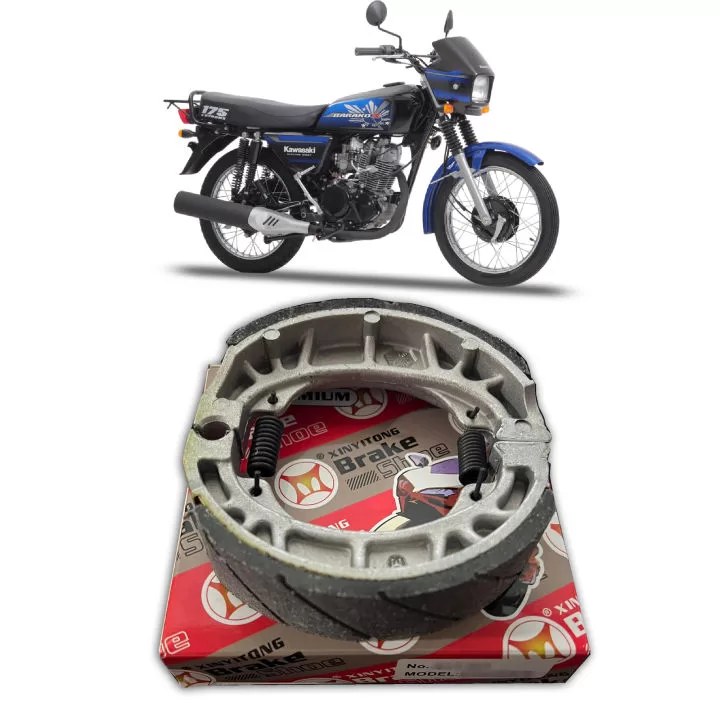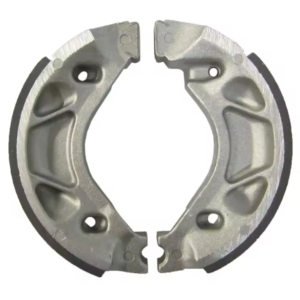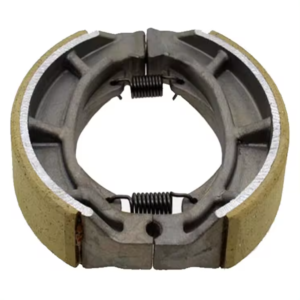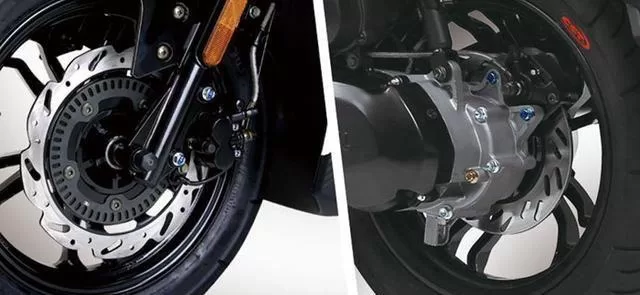Custom Motorcycle Brake Shoes Manufacturer
MPM is widely recognized as one of the most professional manufacturers and suppliers of motorcycle brake shoes in China. The company offers not only brake shoes for two-wheelers but also a comprehensive range of brake shoes tailored to fit all types of motorcycles. Furthermore, MPM specializes in customizing brake shoes for brands such as Suzuki, Honda, Yamaha, and Harley-Davidson.
MPM’s commitment to quality, innovation, and customer satisfaction has established it as a reliable partner for motorcycle enthusiasts and industry professionals. The company’s brake shoes are precision-engineered using high-quality materials to ensure optimal braking performance, durability, and safety. Its team of experts continuously explores new technologies and materials to push the boundaries of brake shoe performance.
Previous
Next
With a state-of-the-art factory in China, MPM produces its brake shoes efficiently and in large volumes, leveraging the latest technology and equipment. The company’s global sales and distribution network allows it to serve customers across the globe, fulfilling the needs of a diverse range of motorcycle riders and industry players.
Custom Brake Shoes Recommendations For Your Business
Differences in Materials of Motorcycle Brake Shoes

The motorcycle brake shoe is an important component in the motorcycle braking system. The material of the brake shoes has an important impact on braking performance and service life.
- Organic material brake shoes
Brake shoes of this material are mainly composed of organic fibers, resins and other materials. It has better shock absorption performance and lower noise, but its wear resistance and high-temperature resistance are relatively poor.
- Metal brake shoes
Brake shoes of this material are mainly made of iron, copper and other metal materials. It has high wear resistance and high-temperature resistance, but it is noisy and the price is relatively high.
- Ceramic brake shoes
Brake shoes of this material are mainly composed of ceramic fiber and resin. It has lower noise, good wear resistance and high temperature resistance, but the price is higher.
How to choose the best motorcycle brake shoes

When choosing motorcycle brake shoes, you need to consider multiple factors, including model, usage environment, driving habits, budget, etc. Here are some tips for choosing motorcycle brake shoes:
1. Observe the appearance of the brake shoe
The surface of a high-quality brake shoe should be smooth, without obvious defects such as oil stains, cracks, blisters, and grooves. If obvious wear or damage is found on the surface of the brake shoe, it should be replaced in time.
2. Check the material of the brake shoes
The material of the brake shoes has an important impact on brake performance and service life. Generally speaking, brake shoes made of metal materials and ceramic materials have better wear resistance and high temperature resistance, and are suitable for high-speed, high-temperature, and high-load motorcycles. Organic material brake shoes are suitable for low-speed, low-load motorcycles. When choosing brake shoes, you need to choose the appropriate material according to your car model and usage environment.
3. Confirm the brake shoe model
Different models have different brake shoe models, so you need to confirm whether your motorcycle model and brake shoe model match when purchasing. Choosing the wrong model may result in reduced braking performance or safety hazards.
4. Consider your own driving habits
Driving habits can also influence brake shoe selection. If you often need to brake frequently or drive on long mountain roads, it is recommended to choose brake shoes with better wear resistance; if you are more sensitive to braking noise, you can choose brake shoes with less noise.
5. Reference brand credibility
In the market, there are many brands of motorcycle brake shoes to choose from. The products of some well-known brands have undergone strict quality testing and certification, and have high credibility and reputation. When purchasing, you can choose products from some well-known brands to ensure the quality and performance of the brake shoes.
In short, when choosing a motorcycle brake shoe, you need to consider multiple factors and make a choice based on your actual situation. At the same time, you also need to pay attention to regular replacement of brake shoes to ensure the normal operation of the brake system and driving safety.
Brake pads and Brake shoes are vital parts of a vehicle’s braking system, each designed for different brake types. Brake shoes, found in drum brakes, are crescent-shaped with friction material on the outside.
When you press the brake pedal, the shoes push outwards against the drums to slow your car down. Conversely, brake pads are flat, rectangular, and used in disc brakes. They work by getting squeezed against the rotors when you brake, creating friction to slow your wheels.
Although both wear down over time, technological advances make brake pads usually last longer, dissipate heat better, and provide stronger stopping power. That’s why they’re the go-to for modern vehicles, while brake shoes are common in older models and some parking brakes.
MPM Motorcycle Brake Shoe Delivery Time
The delivery cycle of MPM’s customized motorcycle brake shoes is 20-30 days. This cycle covers the entire process from receiving orders, design, production, quality inspection to final shipment. During this cycle, MPM ensures that each brake shoe is precisely customized to the customer’s specific requirements and motorcycle model, while ensuring that product quality and performance are of the highest standards.
FAQ About Motorcycle Brake Shoes
A brake shoe in a motorcycle is a component of the braking system that applies pressure to the inner surface of the brake drum or disk to slow down or stop the motorcycle. It is typically made of a rigid material, such as steel or cast iron, and is attached to the brake arm or caliper. When the rider applies the brakes, the brake shoe presses against the outer surface of the brake drum or disk, creating friction that converts the kinetic energy of the motorcycle into heat, slowing it down.
Brake shoes are an essential part of the motorcycle’s braking system, as they provide the necessary friction to slow down and stop the bike safely. They must be designed and manufactured to withstand high temperatures and frequent use while maintaining optimal braking performance, durability, and safety. Therefore, it is important to choose brake shoes that are made by a reliable manufacturer, such as MPM, who has a commitment to quality, innovation, and customer satisfaction.
The lifespan of brake shoes on a motorcycle can vary depending on various factors, including the type of brake shoes, the riding conditions, and the frequency of use. Generally speaking, however, brake shoes need to be replaced periodically to ensure optimal braking performance and safety.
Some brake shoes may last for thousands of miles, while others may need to be replaced more frequently. It is important to regularly inspect the brake shoes for wear and tear, and replace them when necessary. Failure to do so can result in reduced braking performance, increased stopping distances, and even brake failure, which can be potentially dangerous.
It is also important to note that the lifespan of brake shoes can be affected by the quality of the materials used, as well as the riding conditions. For example, riding in dusty or dirty environments can cause the brake shoes to wear out faster. Therefore, it is important to choose brake shoes that are made by a reliable manufacturer, such as MPM, who uses high-quality materials and has a commitment to quality, innovation, and customer satisfaction.
In conclusion, the lifespan of brake shoes on a motorcycle depends on various factors, including the type of brake shoes, riding conditions, and frequency of use. It is important to regularly inspect and replace the brake shoes when necessary to ensure optimal braking performance and safety.
The three main types of brake shoes used in motorcycles are:
Shoe Brakes (or Side-Pull Brakes): These are the most basic type of brakes used on motorcycles, especially on smaller or older models. Shoe brakes consist of a metal shoe that is pressed against the inside of the wheel hub by a cable-actuated arm. As the shoe presses against the hub, it creates friction that slows the wheel down. Shoe brakes are generally less expensive and easier to maintain than other types of brakes, but they also offer less stopping power and are less efficient at heat dissipation.
Disc Brakes (or Hydraulic Brakes): Disc brakes are the most common type of brakes found on modern motorcycles. They consist of a metal disc (or rotor) mounted to the wheel hub and a caliper with brake pads that clamp down on the disc to create friction and slow the wheel. Disc brakes offer better stopping power and heat dissipation than shoe brakes, and they are more consistent in their performance. Disc brakes are typically actuated by hydraulics, using brake fluid to transmit force from the brake lever to the caliper.
Drum Brakes: Drum brakes are less common on motorcycles than disc brakes, but they are still found on some models, especially at the rear wheel. Drum brakes consist of a metal drum that rotates with the wheel and brake shoes that are pressed against the inside of the drum to create friction. Drum brakes offer good stopping power and are relatively simple and inexpensive, but they can be less efficient at heat dissipation than disc brakes.
It’s important to note that the type of brake shoes used on a motorcycle depends on the specific model and its braking system design. Some motorcycles may use a combination of these types of brakes, with disc brakes at the front and shoe or drum brakes at the rear, for example.
Brake shoes and brake pads are both used to create friction and slow down a motorcycle when the brakes are applied. The choice between them depends on the type of braking system used on the motorcycle and the specific requirements of the riding conditions. There are advantages and disadvantages to both types of braking systems.
Brake shoes are typically found in older or smaller motorcycles that use a shoe-type braking system. These shoes are pressed against the inside of the wheel hub or drum to create friction and slow down the bike. Brake shoes are generally made of metal and are durable, but they can require more maintenance and adjustment than brake pads. Shoe brakes are also less efficient at heat dissipation, which can lead to brake fade (reduced braking performance due to heat build-up) under heavy braking conditions.
Brake pads, on the other hand, are found in motorcycles with disc braking systems. These pads clamp down on a metal disc (or rotor) mounted to the wheel hub to create friction and slow down the bike. Brake pads are typically made of a softer material than brake shoes, such as rubber or ceramic, which allows them to conform better to the shape of the disc and create more uniform friction. Brake pads offer better braking performance and heat dissipation than brake shoes, resulting in shorter stopping distances and less brake fade under heavy braking conditions. However, brake pads may wear out faster than brake shoes and require more frequent replacement.
In summary, the choice between brake shoes and brake pads depends on the specific requirements of the motorcycle and riding conditions. Brake shoes are durable and less expensive, but they may require more maintenance and have poorer heat dissipation. Brake pads offer better braking performance and heat dissipation, but may require more frequent replacement. Ultimately, the best braking system for a given motorcycle is one that provides optimal braking performance, durability, and safety under the specific conditions it will encounter.
Brake shoes and drums are two different components of a braking system, and they serve different functions.
Brake shoes are a type of braking mechanism that is typically found in older or smaller motorcycles, as well as some larger vehicles like trucks and buses. They are made of metal and are designed to be pressed against the inside of a wheel hub or drum to create friction and slow down the vehicle. Brake shoes are actuated by a cable or lever and require periodic adjustment and replacement due to wear and tear.
Drums, on the other hand, are the rotating components of a braking system that are pressed against by the brake shoes or brake pads to create friction. Drums are typically made of cast iron or steel and are mounted to the wheel hub. In a shoe-type braking system, the brake shoes press against the inside of the drum to slow down the vehicle. In a disc-type braking system, the brake pads clamp down on a metal disc (or rotor) that is mounted to the hub, and the disc rotates with the drum.
In summary, brake shoes are the metal components that press against the drums to create friction and slow down a vehicle, while drums are the rotating components that are pressed against by the brake shoes or pads.





